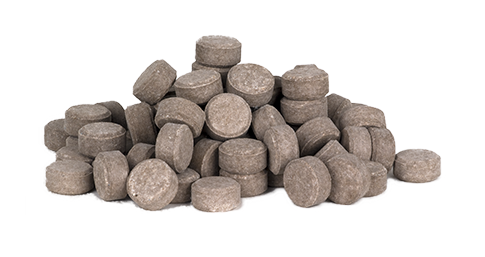EFFICIENCY OF SILVAMIX FERTILISERS IN FOREST NURSERIES
At present, a continuous process of reforestation is, together with the need of the stability and uniformity, one of the pillars that enable a proper working of all functions of forest stands. In spite of an increased interest of foresters in natural forest regeneration it is also necessary to remember than not always the forest manager operates under such conditions that would allow to use the process on natural forest reproduction and for that reason also artificial forest regeneration of forest stands remains to be very important. However, even in case that the forest manager uses and/or combines methods of natural forest regeneration with artificial reforestation it is necessary to remember that the use of vital and top quality transplants and seedlings of forest wood species is very important because they meet requirements of professional standards on the one hand and assure a good physiological condition and nutritional status of young trees on the other
Production of healthy and robust seedlings of forest woody species and their supply to forest managers belong to very important tasks of forest nurseries. To meet these requirements, producers of planting stock must take care above all about good nutrition of young plants and quality of soil in forest nurseries.
For the time being, unfortunately, the silvicultural practice does not pay always an adequate attention to methods of fertilisation and nutrition of seedlings; problems of land improvement and reclamation are also neglected and for that reason methods of dressing and reclamation occupy often only a secondary position in the system of forest management, mostly due to high financial requirements and costs.
However, these relatively high costs and the lack of money are factors that force forest managers to look for new and more efficient methods of fertilisation enabling a prolongation of intervals existing between two dates of dressing, assuring a more uniform supply of nutrients and reducing the overall costs associated with fertilisation and nutrition of forest stands. These were the main reasons of studies on the efficiency application of SILVAMIX®MG fertilisers in forest nurseries and on their effects on both the growth of seedlings and soil fertility.
Methods and Objectives
This paper deals with four basic aspects of the influence of the SILVAMIX®MG fertiliser on seedlings of forest woody species transplants and seedlings, viz. growth characteristics, nutrition, preservation of soil fertility and production of both aboveground and root biomass. The objective was to demonstrate efficiency of the above fertiliser and to summarise results obtained in forest nurseries Zelená Bouda near Brandýs nad Labem and Hájek (district PÃsek). Results were compared with efficiency of a common fertiliser CERERIT® and with control (no dressing at all). When establishing these experiments in both nurseries, doses of nutrients were adjusted to 100 kg N per hectare. This means that in the variant with application of the SILVAMIX®MG fertiliser the supply of nutrients was 144 kg P2O5, 67 kg K2O, and189 kg MgO while in the variant with CERERIT® the corresponding doses were 82 kg P2O5, 127 kg K2O, and 2 kg MgO.
After the application of these fertilisers the following parameters were followed: growth and development of transplants and seedlings (their height, current increment and thickness), nutritional status of planting stock (declared by means of leaf analyses), effects on soil fertility, and effects on the development of the root system.
Results of individual estimations and data concerning individual forest tree species are presented in the following tables.
Table 1. A survey of measurements performed in the nursery Zelená bouda
| Zelená bouda | |||||
|---|---|---|---|---|---|
| Date of the establishment | Spring 1997 | ||||
| Species under study | Oak Quercus robur | Pine Pinus silvestris | Norway spruce Picea abies | Norway spruce Picea abies | Fir Abies alba |
| Age at the beginning of the experiment | Sowing Spring 1997 | Sowing Spring 1997 | 2/0 Nursering Autumn 1996 | 2/0 Nursering Spring 1997 | 2/0 Nursering Spring 1997 |
Forest tree species under study were of the following provenience:
B/BO/18/18b/2/MB
B/SM/405/25/6/RK - Autumn nursering
B/SM/43/2a/3/SO - Spring nursering
B/JD/CHKO/16/6/ZR
In case of Q. robur the number of approved seed material was not ascertained because all seedling were ploughed in after the end of the first growing season.
Table 2. A survey of measurements performed in the nursery Hájek
| Hájek | |||||
|---|---|---|---|---|---|
| Date of the establishment | Spring 1998 | ||||
| Species under study | Douglas fir Pseudotsuga menziesii | Norway spruce Picea abies | Lime tree Tiliacordata | Beech Fagussilvatica | FirAbies alba |
| Age at the beginning of the experiment | 2/0 Nursering Spring 1998 | 2/0 Nursering Spring 1998 | 2/0 Nursering Spring 1998 | 2/0 Nursering Spring 1998 | Sowing Spring 1998 |
Forest tree species under study were of the following provenience:
B/DG/105/10/4/PI
B/SM/130/10/3/BN
B/BK/66/10/5/PI
0/LP/00/10/4/PI
B/JD/045/10/4/PI
Biometric measurements
Evaluated were the following parameters: height, increment and thickness of seedlings. The total number of measured seedlings was 3,150.
Soil analyses
Altogether three samplings of soil were performed to evaluate the effect of fertilisers under study on reserves of available nutrients in soil and on preservation of soil fertility (pH, nutrient levels). Soil samples were analysed in the pedological laboratory in Kostelec nad Černými lesy.
Leaf analyses
The nutritional status of transplants and seedlings after the application of individual fertilisers was evaluated by means of leaf analyses which were performed only in seedlings originating from the nursery Hájek with the objective to evaluate their nutritional status after the application of individual fertilisers.
Weight characteristics
Production of biomass of transplants and seedlings after the application of individual fertilisers was the last parameter under study. The weight was estimated only in coniferous woody species because at the moment of sampling the deciduous trees were without assimilation organs so that it was not possible to estimate the total biomass production. Followed was the production of total biomass and the ratio existing between the tops and roots of transplants and seedlings. In this part of our experiments attention was paid to the development of the root system in relation to the production of total biomass and biomass of tops because it is important to prevent the atrophy of the root system in case of an inadequate supply of nutrients.
Characteristics of fertilisers under study SILVAMIX®MG
A specific trait of SILVAMIX® fertilisers is the fact that their development and production have been oriented to the needs of silvicultural practice since the year 1986. At the very beginning they were developed for the application on immission clearings in the Ore Mountains (North-West Bohemia region).
Today, this fertiliser is used for dressing of both forest stands and nursery transplants. For practical application, it is manufactured in several forms (powder, tablets) and types (containing different elements).
Characteristics of fertilisers under study CERERIT®
The fertiliser SILVAMIX®MG was compared with a standard Fast Release Agricultural Fertiliser CERERIT® (NPK-10.0-8.5-14.0+1.3 MgO) which also contains nutrients in a chloride-free form and has been used in silviculture and especially in forest nurseries for many years. However, as compared with fertilisers of SILVAMIX® series, it is usually dissolved within one growing season.
Evaluation of effects of SILVAMIX® fertilisers on the growth of planting stock
When evaluating the biometrical part of our experiments it is possible to say that the positive effect of SILVAMIX®MG fertiliser on the growth of transplants and seedlings was corroborated. A gradual release of nutrients showed a positive effect on growth of all tree species but, especially, of such demanding species as oak and fir. Transplants fertilised with SILVAMIX®MG showed also good parameters of root necks.
In the Zelená bouda nursery the height of plants, annual increments and thickness of transplants and seedlings were evaluated and it was found out that the application of the SILVAMIX®MG fertiliser was successful in 80 % of cases.
In the Hájek nursery the corresponding result was also 80 % (24 positive responses to SILVAMIX®MG of 30 evaluated). The positive effect was manifested especially in the second growing season, i. e. after the depletion of common fertilisers. These results explicitly demonstrate positive effects of SILVAMIX®MG fertilisers on growth processes of planting stock.
Evaluation of effects of SILVAMIX®MG fertilisers on soil condition
Generally, it can be concluded that the fertilisers under study did not show a direct effect on changes in soil fertility as far as the contents of humus and nitrogen are concerned. The SILVAMIX®MG fertiliser, on the other hand, can influence the soil reaction, especially due to its sufficient content of potassium. It can be used above all when modifying the amounts of available nutrients because its effects on soil are much better than those of other fertilisers (CERERIT®). As demonstrated by results of laboratory analyse mentioned above, released nutrients are available in increased amounts in the upper soil layer due to a slow release of the fertiliser. As compared with CERERIT®, a reduced concentration of nutrients under SILVAMIX®MG can be observed in lower soil layers; this indicates that plants utilise released nutrients for their growth and than the rate of their wash off into lower soil layers does not occur.
Evaluation of effects of SILVAMIX®MG fertilisers on the level of nutrition
Results of leaf analyses (Supplement - Figs 1-5) indicated that there were no marked differences between experimental variants. The content of nitrogen was generally low in all tree species. In spite of all expectations the effect of SILVAMIX®MG fertiliser was not manifested too much, especially as far as the supply of magnesium to transplants was concerned. However, it is necessary to mention that the sampling was carried out only in one nursery and that the number of samples was not very high. In our opinion, therefore, it would not be appropriate to draw conclusions only on the base of the obtained results and it would be more For that reason it seem to be reasonable to carry out further studies on this problem in near future.
Evaluation of effects of SILVAMIX®MG fertilisers on the development of the root system
It was found out that after the application of SILVAMIX®MG fertiliser the ratio between production of biomass of tops and roots of young forest trees was near to the optimum and that the quality of transplants was also very high. The evaluation of this roots/tops ratio was based on requirements defined in the standard ÄŒSN 48 21 15 (Tab.16).
Obtained results (Tabs 17 - 23) indicate that the SILVAMIX®MG fertiliser does not show any negative effects on the development of roots and that its potential promoting effect on the growth of transplants is not associated with any inhibition of the root system.
Discussion
The SILVAMIX®MG fertiliser (manufacturer ECOLAB ZNOJMO spol. s r.o.) can be classified as a true slow-release fertiliser and that it is efficient for at least two years. This fact was demonstrated also in this study. A positive effect of this fertiliser on growth of transplants was observed in both nurseries especially in the second year and in the nursery Zelená Bouda also in the third year. In the nursery Hájek, a very positive effect was observed also in the third year after its application because one-year-old seedlings planted on beds treated with SILVAMIX®MG were markedly higher than those grown on beds dressed with CERERIT® and/or untreated.
It is this long period of release that assures an optimum supply of nutrients to plants and creates favourable conditions for their growth and development. Besides, SILVAMIX®MG shows positive effects on soil fertility. An explicitly positive effect of SILVAMIX®MG was demonstrated in case of nutrients available to plants. As higher amounts of nutrients were accumulated in upper soil layers, it is clear that they are not washed off to the underground.
The content of magnesium in soil was very favourable. This indicates that it would be advisable to investigate possibilities of use of SILVAMIX®MG fertiliser when producing transplants for regions with a high degree of imissions because, initially, this fertiliser was developed as a source of nutrients for reforested slopes in the Krušné hory mountains. Its high content of magnesium was an important factor of this project as the reserves of this element in soil may be a limiting factor for a proper growth and development of forest stands. However, if we were able to produce with SILVAMIX®MG such transplants that could have sufficient reserves of necessary nutrients and could be also supplementary dressed with fertilisers of this type, we could help young plants to overcome the shock after transplantation and, possibly, to improve the growth of young forest stand.
The SILVAMIX®MG fertiliser shows also a positive effect on the development of root system. Roots are of good quality, with a sufficient length and many root hairs. This means that there will be no problems with the survival rate of transplants due to an underdeveloped root system.
Fertiliser of the SILVAMIX® series gave positive results in numerous experiments and they could be recommended for production of regular transplants of forest tree species and/or for application under special conditions. Fertilisers of the SILVAMIX® series could be very useful for nurseries established on sandy soils with a low binding capacity and leaching of nutrients from the soil profile. In such cases, SILVAMIX® fertilisers can be used especially because of their slow release of nutrients and ability to supply them into the soil at a steady and continuous pace. Last but not least, the SILVAMIX®MG fertiliser can be recommended also for growing of some very demanding tree species, e. g. fir and beech; in such a situation the effect of SILVAMIX®MG fertiliser on young trees was very positive.
Conclusions
The current situation on the market with tree transplants is characterised partly by surplus production and partly by sharp competition among producers. This competitive pressure contributes to the improvement of quality of produced seedlings and transplants of forest tree species. Forest owners and managers, as well, require planting stock of a good quality because they want to reduce their costs associated with reforestation and establishment of new plantations.
If one takes genetic quality of nursery stock for granted, it is necessary to pay increased attention to morphological and physiological aspects of young trees. This can be reached only on the base of a combination of many silvicultural measures that affect the final quality of produced transplants. There is no doubt that application of fertilisers belongs to them and it can be said that their effect are doubled: they influence positively not only transplants and seedlings but also fertility of soil.
The obtained results indicate that the SILVAMIX®MG fertiliser shows a positive effect on the growth increments of nursery stock and increases the total height of young trees. Application of SILVAMIX®MG fertilisers results in improved parameters of root collar thickness and in a well developed root system with an abundance of fine hairy roots. As shown by means of leaf analyses, there were no excessive differences among individual experimental variants of dressing on the one hand and no negative effects of SILVAMIX®MG on the other.
The tested fertiliser showed also a positive effect on soil fertility. These effects were manifested in two ways: (1) supply of nutrients was adequate and took place at a steady pace due to a slow release of nutrients for at least two years; (2) application of SILVAMIX® fertilisers also improved soil acidity, especially due to a high content of magnesium and its release into the soil.
Supplements
Table 3. Height of transplants and seedlings in the nursery Zelená Bouda, autumn 1997
| Woody species, age of plants and year of the experiment establishment | Oak 1/0 Sowing 1997(cm) | Pine 1/0 Sowing 1997(cm) | Norway spruce 2/1Nursing - autumn 1996 (cm) | Norway spruce 2/1 Nursing - spring 1997(cm) | Fir 2/1 Nursing - spring 1997(cm) |
|---|---|---|---|---|---|
| Fertilisers | |||||
| CONTROL | 8.5 a | 5.0 a | 8.0 a | 6.9 a | 9.4 a |
| CERERIT | 9.8 b | 5.5 b | 12.4 b | 9.1 b | 12.4 b |
| SILVAMIX | 11.1 b | 6.6 c | 13.6 c | 9.6 b | 12.3 b |
Table 4. Height of transplants and seedlings in the nursery Zelená Bouda, autumn 1998
| Woody species, age of plants and year of the experiment establishment | Pine 2/0Sowing 1997(cm) | Norway spruce 2/2Nursing -autumn 1996 (cm) | Norway spruce 2/2 Nursing -spring 1997(cm) | Fir 2/2 Nursing - spring 1997(cm) |
|---|---|---|---|---|
| Fertilisers | ||||
| CONTROL | 15.0 a | 24.6 a | 17.2 a | 16.0 a |
| CERERIT | 15.2 a | 28.4 b | 21.8 b | 17.9 b |
| SILVAMIX | 14.3 a | 29.1 b | 21.7 b | 19.0 c |
Table 5. Current increments in the nursery Zelená Bouda, autumn 1998
| Woody species, age of plants and year of the experiment establishment | Pine 2/0Sowing 1997(cm) | Norway spruce 2/2Nursing -autumn 1996 (cm) | Norway spruce 2/2 Nursing -spring 1997(cm) | Fir 2/2 Nursing -spring 1997(cm) |
|---|---|---|---|---|
| Fertilisers | ||||
| CONTROL | 11.8 a | 8.2 a | 6.8 a | 4.6 a |
| CERERIT | 11.6 a | 8.4 a | 8.4 b | 5.6 b |
| SILVAMIX | 9.7 b | 8.6 a | 8.4 b | 6.6 c |
Table 6. Root collar size of transplants and seedlings in the nursery Zelená Bouda, autumn 1998
| Woody species, age of plants and year of the experiment establishment | Pine 2/0Sowing 1997(cm) | Norway spruce 2/2Nursing -autumn 1996 (cm) | Norway spruce 2/2 Nursing -spring 1997(cm) | Fir 2/2 Nursing -spring 1997(cm) |
|---|---|---|---|---|
| Fertilisers | ||||
| CONTROL | 3.3 a | 6.1 a | 4.5 a | 5.2 a |
| CERERIT | 3.8 b | 6.5 a | 4.6 a | 5.5 a |
| SILVAMIX | 3.9 b | 6.2 a | 5.0 b | 6.2 b |
Table 7. Height of transplants in the nursery Zelená Bouda,. autumn 1999
| Woody species, age of plants and year of the experiment establishment | Norway spruce 2/3 Nursing - autumn 1996 (cm) | Norway spruce 2/3 Nursing - spring 1997 (cm) |
|---|---|---|
| Fertiliser | ||
| CONTROL | 30.76 a | 28.36 a |
| CERERIT | 37.86 b | 29.72 a |
| SILVAMIX | 41.42 c | 32.08 b |
Table 8. Height increment of transplants in the nursery Zelená Bouda, autumn 1999
| Woody species, age of plants and year of the experiment establishment | Norway spruce 2/3 Nursing - autumn 1996 (cm) | Norway spruce 2/3 Nursing - spring 1997 (cm) |
|---|---|---|
| Fertiliser | ||
| CONTROL | 8.36 a | 9.02 a |
| CERERIT | 8.22 a | 9.24 a |
| SILVAMIX | 14.44 b | 12.34 b |
Table 9. Root collar size in the nursery Zelená Bouda, autumn 1999
| Woody species, age of plants and year of the experiment establishment | Norway spruce 2/3 Nursing - autumn 1996 (mm) | Norway spruce 2/3 Nursing - spring 1997 (mm) |
|---|---|---|
| Fertiliser | ||
| CONTROL | 7.98 a | 6.18 a |
| CERERIT | 9.40 b | 5.78 a |
| SILVAMIX | 9.92 c | 6.86 b |
Table 10. Height of transplants and seedlings in the nursery Hájek, autumn 1997
| Woody species, age of plants and year of the experiment establishment | Fir 1/0 Sowing 1998 (cm) | Norway spruce 2/1 Nursing -spring 1998 (cm) | Douglas fir 2/1 Nursing - spring 1997 (cm) | Lime tree 2/1 Nursing -spring 1998 (cm) | Oak 2/1 Nursing - spring 1998 (cm) |
|---|---|---|---|---|---|
| Fertiliser | |||||
| CONTROL | 5.16 a | 22.84 a | 25.16 a | 51.46 a | 33.98 a |
| CERERIT | 6.34 b | 23.12 a | 29.22 b | 52.06 a b | 32.68 a |
| SILVAMIX | 5.78 c | 24.28 b | 28.96 b | 53.98 b | 32.94 a |
Table 11. Height increment of transplants and seedlings in the nursery Hájek, autumn 1998
| Woody species, age of plants and year of the experiment establishment | Norway spruce 2/1 Nursing spring 1998 (cm) | Douglas fir 2/1 Nursing - spring 1997 (cm) | Lime tree 2/1 Nursing - spring 1998 (cm) | Oak 2/1 Nursing - spring 1998 (cm) |
|---|---|---|---|---|
| Fertiliser | ||||
| CONTROL | 8.18 a | 10.24 a | 24.22 a | 6.24 a |
| CERERIT | 8.82 a b | 11.98 b | 26.72 b | 5.94 a |
| SILVAMIX | 9.22 b | 11.52 a b | 28.18 b | 6.64 a |
Table 12. Thickness of root collar of transplants and seedlings in the nursery Hájek, autumn 1998
| Woody species, age of plants and year of the experiment establishment | Fir 1/0 Sowing 1998 (cm) | Norway spruce 2/1 Nursing -spring 1998 (cm) | Douglas fir 2/1 Nursing - spring 1997 (cm) | Lime tree 2/1 Nursing - spring 1998 (cm) | Oak 2/1 Nursing - spring 1998 (cm) |
|---|---|---|---|---|---|
| Fertiliser | |||||
| CONTROL | 1.68 a | 5.26 a | 4.84 a | 9.64 a | 5.86 a |
| CERERIT | 2.04 b | 5.46 a b | 5.24 a | 10.32 b | 5.82 a |
| SILVAMIX | 1.84 a | 5.78 b | 5.38 a | 10.60 b | 5.90 a |
Table 13. Height of transplants and seedlings in the nursery Hájek, autumn 1999
| Woody species, age of plants and year of the experiment establishment | Fir 1/0 Sowing 1998 (cm) | Norway spruce 2/1 Nursing - spring 1998 (cm) | Douglas fir 2/1 Nursing -spring 1997 (cm) | Lime tree 2/1 Nursing - spring 1998 (cm) | Oak 2/1 Nursing - spring 1998 (cm) |
|---|---|---|---|---|---|
| Fertiliser | |||||
| CONTROL | 10.98 a | 32.42 a | 44.12 a | 99.74 a | 42.18 a |
| CERERIT | 11.98 b | 38.26 b | 45.42 a | 114.66 b | 48.38 b |
| SILVAMIX | 13.30 c | 41.68 c | 53.34 b | 115.06 b | 57.20 c |
Table 14. Height increment of transplants and seedlings in the nursery Hájek, autumn 1999
| Woody species, age of plants and year of the experiment establishment | Fir 2/0 Sowing 1998 (cm) | Norway spruce 2/2 Nursing -spring 1998 (cm) | Douglas fir 2/2 Nursing - spring 1997 (cm) | Lime tree 2/2 Nursing - spring 1998 (cm) | Oak 2/2 Nursing - spring 1998 (cm) |
|---|---|---|---|---|---|
| Fertiliser | |||||
| CONTROL | 5.64 a | 11.94 a | 20.60 a | 53.12 a | 11.12 a |
| CERERIT | 6.56 b | 15.86 a | 20.66 a | 65.26 b | 15.80 b |
| SILVAMIX | 8.32 c | 18.94 b | 29.18 b | 65.28 b | 26.22 c |
Table 15. Thickness of root collars of transplants and seedlings in the nursery Hájek, autumn 1999
| Woody species, age of plants and year of the experiment establishment | Fir 2/0 Sowing 1998 (mm) | Norway spruce 2/2 Nursing -spring 1998 (mm) | Douglas fir 2/2 Nursing - spring 1997 (mm) | Lime tree 2/2 Nursing - spring 1998 (mm) | Oak 2/2 Nursing - spring 1998 (mm) |
|---|---|---|---|---|---|
| Fertiliser | |||||
| CONTROL | 2.10 a | 6.90 a | 8.60 a | 14.48 a | 8.50 a |
| CERERIT | 2.26 a | 7.58 a | 8.72 a | 16.50 b | 9.58 b |
| SILVAMIX | 2.64 b | 8.90 b | 10.26 b | 16.52 b | 9.78 b |
Table 16. Optimum weight characteristics of planting stock
| Optimum weight characteristics of planting stock of forest tree species | ||
|---|---|---|
| Woody species | Ratio of the root system to tops | Minimum share of fine roots in the volume of the whole root system |
| Pine | 1/4 (25%) | 20 % |
| Norway spruce | 1/3 (33%) | 30 % |
| Fir | 1/2 (50%) | 25 % |
| Douglas fir | 1/3 (33%) | 30 % |
Table 17. Weight characteristics of pine
| Weight characteristics of pine - Zelená Bouda | |||||
|---|---|---|---|---|---|
| Variant | Weight of tops (g) | Weight of fine roots (g) | Total weight of roots (g) | Ratioroots/tops | Share of fine roots % |
| CONTROL | 9.520 | 1.988 | 2.603 | 27 | 76 |
| CERERIT | 21.160 | 2.860 | 4.156 | 20 | 69 |
| SILVAMIX | 13.827 | 2.394 | 3.433 | 25 | 70 |
Table 18. Weight characteristics of Norway spruce nursed in the autumn
| Weight characteristics of Norway spruce. autumn nursing - Zelená Bouda | |||||
|---|---|---|---|---|---|
| Variant | Weight of tops (g) | Weight of fine roots (g) | Total weight of roots (g) | Ratioroots/tops | Share of fine roots % |
| CONTROL | 34.167 | 9.221 | 17.053 | 50 | 54 |
| CERERIT | 42.944 | 6.653 | 12.388 | 29 | 54 |
| SILVAMIX | 42.751 | 7.777 | 15.590 | 37 | 50 |
Table 19. Weight characteristics of Norway spruce nursed in the spring
| Weight characteristics of Norway spruce. spring nursing - Zelená Bouda | |||||
|---|---|---|---|---|---|
| Variant | Weight of tops (g) | Weight of fine roots (g) | Total weight of roots (g) | Ratioroots/tops | Share of fine roots % |
| CONTROL | 16.147 | 3.200 | 6.448 | 40 | 50 |
| CERERIT | 20.642 | 4.705 | 8.452 | 41 | 56 |
| SILVAMIX | 28.616 | 7.333 | 14.426 | 50 | 51 |
Table 20. Weight characteristics of fir
| Weight characteristics of fir - Zelená Bouda | |||||
|---|---|---|---|---|---|
| Variant | Weight of tops (g) | Weight of fine roots (g) | Total weight of roots (g) | Ratioroots/tops | Share of fine roots % |
| CONTROL | 16.775 | 7.880 | 12.808 | 76 | 62 |
| CERERIT | 22.609 | 6.846 | 13.820 | 61 | 50 |
| SILVAMIX | 34.252 | 10.419 | 18.342 | 54 | 57 |
Table 21. Weight characteristics of fir
| Weight characteristics of fir - Hájek | |||||
|---|---|---|---|---|---|
| Variant | Weight of tops (g) | Weight of fine roots (g) | Total weight of roots (g) | Ratioroots/tops | Share of fine roots % |
| CONTROL | 3.992 | 1.053 | 2.069 | 52 | 51 |
| CERERIT | 3.847 | 1.260 | 2.365 | 62 | 53 |
| SILVAMIX | 2.885 | 1.290 | 1.914 | 66 | 67 |
Table 22. Weight characteristics of Norway spruce
| Weight characteristics of Norway spruce - Hájek | |||||
|---|---|---|---|---|---|
| Variant | Weight of tops (g) | Weight of fine roots (g) | Total weight of roots (g) | Ratioroots/tops | Share of fine roots % |
| CONTROL | 46.845 | 9.530 | 26.401 | 56 | 36 |
| CERERIT | 53.891 | 17.085 | 37.773 | 70 | 45 |
| SILVAMIX | 56.382 | 18.365 | 41.267 | 73 | 45 |
Table 23. Weight characteristics of Douglas fir
| Weight characteristics of Douglas fir - Hájek | |||||
|---|---|---|---|---|---|
| Variant | Weight of tops (g) | Weight of fine roots (g) | Total weight of roots (g) | Ratioroots/tops | Share of fine roots % |
| CONTROL | 54.535 | 11.978 | 27.466 | 50 | 44 |
| CERERIT | 69.150 | 16.690 | 38.086 | 55 | 44 |
| SILVAMIX® | 66.069 | 16.159 | 32.249 | 53 | 50 |
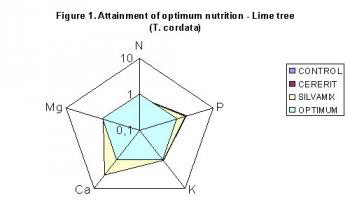 |
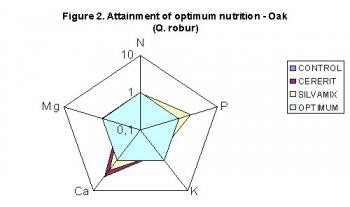 |
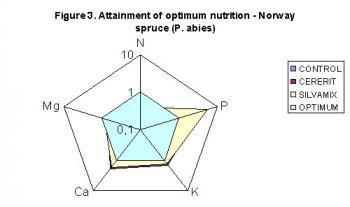 |
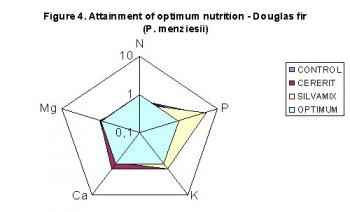 |
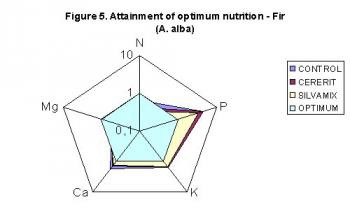 |
References:
- Burda, P.: Účinnost hnojiva SILVAMIX v lesních školkách. (Efficiency of SILVAMIX fertilisers in forest nurseries. Diploma thesis. Prague, Czech Agricultural University, Faculty of Forestry (LF ČZU), 2000, 81 pp.




















